Design Guidelines for Smart Nursing Homes in the Context of Aging
Abstract
:1. Introduction
2. Theoretical Concept and Methodology
- Study of smart device selection criteria based on the next-generation elderly’s requirements: Awareness surveys of the Japanese public were conducted to comprehensively summarize the core needs of the elderly for housing, including safety, convenience, medical support, and psychological comfort. Based on the results of the survey, the smart devices required to satisfy these requirements were sorted out, and the types of devices with practical application value were screened and formed into smart device selection criteria. The smart device selection criteria were combined with the subsequent smart nursing home model templates to form the smart nursing home design guidelines.
- Study smart nursing home model templates based on the next-generation housing requirements: Explore the requirements for next-generation nursing home model types that satisfy the design standards for elderly housing, analyze the role of the existing design standards, the problems they solve and their limitations, and draw next-generation nursing home model types that satisfy both the existing design standards and the requirements for next-generation nursing home and serve as templates for smart nursing home model types. The smart nursing home model templates and the smart device selection criteria constitute the Smart Nursing Homes Design Guidelines. The next-generation nursing home model type serves as a template for the smart nursing home, and smart devices are incorporated into the house type to achieve the goal of smart nursing.
- Proposing Design Guidelines for smart nursing homes: Summarize the study results on the arrangement of household types and smart devices of next-generation nursing homes, clarify the templates of smart nursing home models and the criteria for the selection of smart devices (including the functional positioning, selection criteria, and matching with actual use scenarios), and formulate the guidelines for the design of smart nursing homes. The design guidelines will be used in subsequent smart nursing home design cases to validate the use of the smart nursing home design guidelines.
- Case study of smart nursing home design: Based on the smart nursing home design guidelines, the selected smart devices are combined with the house model templates to clarify the specific functions, placement, and usage of each device. By simulating the actual use scenarios, it verifies the matching degree and application effect between the smart devices with the house model design.
- Uncertainty of changing demand: As technology advances, lifestyle changes, and cultural differences occur, the demand for smart nursing homes for older adults will change. This study minimizes this uncertainty by using data spanning a period of about 12 years.
- Device Reliability and Maintenance Costs: The study focuses on device selection and configuration but does not delve into the stability, failure rate, and maintenance needs of the devices in long-term use, nor does it address the mechanism for updating the devices.
- Cross-country adaptation and policy and regulatory impact: Although the adaptation of smart nursing homes in different countries is considered, the impact of national aging policies and data privacy regulations on the construction of smart nursing homes is not explored in detail, especially health data management and privacy restrictions.
3. Study on Smart Device Selection Criteria Based on the Next-Generation Elderly’s Requirements
4. Study on Smart Nursing Home Model Templates Based on the Next-Generation Housing Requirements
5. Design Guidelines for Smart Nursing Homes
6. Smart Nursing Home Design Case
7. Conclusions
Author Contributions
Funding
Data Availability Statement
Conflicts of Interest
Abbreviations
| LDK | Living room–dining room–kitchen |
| AI | Artificial intelligence |
| JPY | Japanese Yen |
References
- Ministry of Internal Affairs and Communications (MIC). Statistical Topics No.142, Statistics on the Elderly in Japan-On the Occasion of Respect-for-Senior-Citizens Day; Statistics Bureau, Ministry of Internal Affairs and Communications: Tokyo, Japan, 2024. Available online: https://www.stat.go.jp/data/topics/pdf/topics142.pdf (accessed on 25 April 2025).
- Ministry of Health, Labour and Welfare (MHLW). Survey on the Basis of National Life in 2021; Ministry of Health, Labour and Welfare (MHLW): Tokyo, Japan, 2021. Available online: https://www.mhlw.go.jp/toukei/saikin/hw/k-tyosa/k-tyosa21/dl/12.pdf (accessed on 25 April 2025).
- Ministry of Internal Affairs and Communications (MIC). Basic Aggregation of Housing and Households; Statistics Bureau, Ministry of Internal Affairs and Communications: Tokyo, Japan, 2024. Available online: https://www.e-stat.go.jp/stat-search/files?page=1&toukei=00200522&tstat=000001207800 (accessed on 25 April 2025).
- Ministry of Health, Labour and Welfare. Elderly Welfare Act; Ministry of Health, Labour and Welfare: Tokyo, Japan, 2024. Available online: https://elaws.e-gov.go.jp/document?lawid=338AC0000000133 (accessed on 25 April 2025).
- Ministry of Land, Infrastructure, Transport and Tourism. Act on Securement of Stable Housing for the Elderly; Ministry of Land, Infrastructure, Transport and Tourism: Tokyo, Japan, 2024. Available online: https://elaws.e-gov.go.jp/document?lawid=413AC0000000026 (accessed on 25 April 2025).
- Ministry of Health, Labour and Welfare. Long-Term Care Insurance Act; Ministry of Health, Labour and Welfare: Tokyo, Japan, 2025. Available online: https://elaws.e-gov.go.jp/document?lawid=409AC0000000123 (accessed on 25 April 2025).
- Ministry of Health, Labour and Welfare (MHLW). The State of the Service Provision System, etc. toward the Year 2040, Current Status, Issues and Discussion Points; Ministry of Health, Labour and Welfare (MHLW): Tokyo, Japan, 2025. Available online: https://www.mhlw.go.jp/content/12300000/001371773.pdf (accessed on 25 April 2025).
- Zhao, L.; Shen, Z.; Zhang, Y.; Ma, Y. The impact of the community built environment on the walking times of residents in a community in the downtown area of Fuzhou. Sustainability 2019, 11, 691. [Google Scholar] [CrossRef]
- Chen, H.; Shen, Z. Building form regulation visualisation in Japan: Automatic building volume legality verification via procedural modelling. Int. J. Sustain. Soc. 2018, 10, 313–340. [Google Scholar] [CrossRef]
- Guo, X.; Shen, Z.; Zhang, Y.; Wu, T. Review on the application of artificial intelligence in smart homes. Smart Cities 2019, 2, 402–420. [Google Scholar] [CrossRef]
- Shen, Z.; Teng, X.; Zhang, Y.; Fang, G.; Xu, W. Guidelines for Installation of Sensors in Smart Sensing Platforms in Underground Spaces. Sensors 2022, 22, 3215. [Google Scholar] [CrossRef] [PubMed]
- Haj-Saleh, O.; Çağnan, Ç. A Comparative Analysis of the Spatial Design Perspective of Wayfinding: The Emergency Room as a Case Study. Buildings 2025, 15, 516. [Google Scholar] [CrossRef]
- Mirmozaffari, M. Application of Data Envelopment Analysis to Optimize Transfer of Ischemic Stroke Patients for Endovascular Thrombectomy. Master’s Thesis, Faculty of Graduate Studies, Dalhousie University, Halifax, NS, Canada, 2023. [Google Scholar]
- Quesada-García, S.; Valero-Flores, P.; Lozano-Gómez, M. Residential Care Facilities for Users with Alzheimer’s Disease: Characterisation of Their Architectural Typology. Buildings 2024, 14, 3307. [Google Scholar] [CrossRef]
- Kemkomnerd, W.; Tirapas, C. The Digital Twin Immersive Design Process and Its Potential Disruption to Healthcare Design through a User-Centered Approach. Buildings 2024, 14, 2839. [Google Scholar] [CrossRef]
- Relife-Project Senior Administrator. Video Report: The 2025 Problem—The Near Future of Japan’s Aging (Mr. Yoh Satoh, Relife-Project Senior Administrator, The Asahi Shimbun); Foreign Press Center: Tokyo, Japan, 2016. Available online: https://fpcj.jp/en/worldnews-en/briefings-en/p=50113/ (accessed on 25 April 2025).
- Zhang, Y.; Cheng, J.; Shen, Z.; Liu, S.; Teng, X.; Kawakami, M. Study on the construction of energy-saving evaluation index system for the development of low-carbon industrial—A case study in Pingtan of Fujian Province, China. Energy Rep. 2021, 7, 86–92. [Google Scholar] [CrossRef]
- Dan, Y.; Shen, Z.; Zhu, Y.; Huang, L. Using mixed reality (MR) to improve on-site design experience in community planning. Appl. Sci. 2021, 11, 3071. [Google Scholar] [CrossRef]
- Shen, Z.; Fitriaty, P.; Cao, Z.; Dan, Y. The Evolution and Evaluation Index of Smart House Based on the Comparison with Green House. Shanghai Urban Plan. Rev. 2018, 1, 1–11. [Google Scholar]
- Shen, Z.; Lei, Z.; Li, X.; Sugihara, K. Design Coordination Regarding Urban Design Guidelines Using Google Earth. Int. Rev. Spat. Plan. Sustain. Dev. 2013, 1, 53–68. [Google Scholar] [CrossRef] [PubMed]
- Nguyen, D.-T.; Shen, Z.; Honda, K.; Sugihara, K.; Nishino, T.; Truong, M.-H. A GIS-Based Model for Integrating Risk Estimations of Residential Building Damage and Shelter Capacity in the Case of Earthquakes. Nat. Hazards Rev. 2020, 21, 04019016. [Google Scholar] [CrossRef]
- Tanaka, H.; Kawakami, M.; Shen, Z.; Sekiguchi, T.; Toyoshima, Y. A study on measures for disaster prevention in historically dense Urban areas from the viewpoint of fire spread risk. AIJ J. Technol. Des. 2020, 26, 978–983. [Google Scholar] [CrossRef]
- Teng, X.; Shen, Z. Design of a smart visiting service management system for personal information collection in order to integrate tourism management into an isolated island. Appl. Sci. 2020, 10, 6442. [Google Scholar] [CrossRef]
- Huang, G.; Shen, Z.; Mardin, R. Overview of Urban Planning and Water-Related Disaster Management. In Urban Planning and Water-related Disaster Management, 1st ed.; Huang, G., Shen, Z., Eds.; Springer: Cham, Switzerland, 2019; Chapter 1; pp. 1–10. [Google Scholar]
- Huang, G.; Shen, Z. Special issue on Environment management and spatial planning. Int. Rev. Spat. Plan. Sustain. Dev. 2017, 5, 1–3. [Google Scholar] [CrossRef]
- Vrančić, A.; Zadravec, H.; Orehovački, T. The Role of Smart Homes in Providing Care for Older Adults: A Systematic Literature Review from 2010 to 2023. Smart Cities 2024, 7, 1502–1550. [Google Scholar] [CrossRef]
- UDS Foundation (UDSF). A Guide to Aging in Place Design; UDS Foundation (UDSF): Lancaster, PA, USA, 2020; Available online: https://udservices.org/aging-in-place-design/ (accessed on 25 April 2025).
- Department for Communities. Annex B—Housing for Older People Design Standards; Department for Communities. Available online: https://www.communities-ni.gov.uk/articles/annex-b-housing-older-people-design-standards (accessed on 25 April 2025).
- Ministry of Health and Social Affairs. Swedish Social Services Act; Ministry of Health and Social Affairs: Tokyo, Japan, 2001. Available online: https://www.riksdagen.se/sv/dokument-och-lagar/dokument/svensk-forfattningssamling/socialtjanstlag-2001453_sfs-2001-453/ (accessed on 25 April 2025).
- Federal Ministry for Family Affairs and Senior Citizens.; Federal Ministry for Economic Affairs.; Federal Ministry for Spatial Planning, Construction and Urban Development. Regulation on Personnel Requirements for Care Homes (Care Home Personnel Regulation—HeimPersV); Federal Ministry for Family Affairs and Senior Citizens; Federal Ministry for Economic Affairs; Federal Ministry for Spatial Planning, Construction and Urban Development: 1993. Available online: https://www.gesetze-im-internet.de/heimpersv/BJNR120500993.html (accessed on 25 April 2025).
- GB 50340-2016; Code for Design of Residential Building for the Aged. China Standard Press: Beijing, China, 2013.
- Wang, H.; Chen, H. Aging in China: Challenges and Opportunities. China CDC Wkly 2022, 4, 601–602. [Google Scholar] [PubMed]
- Tian, S.; Yang, W.; Le Grange, J.M.; Wang, P.; Huang, W.; Ye, Z. Smart healthcare: Making medical care more intelligent. Glob. Health J. 2019, 3, 62–65. [Google Scholar] [CrossRef]
- Nikkei BP Intelligence Group. Healthy Life Extension Housing Fuyo Development; Nikkei BP Intelligence Group: Tokyo, Japan, 2024; Available online: https://project.nikkeibp.co.jp/atcljsdj/case/10_2/ (accessed on 25 April 2025).
- Anabuki Medical Care Co. A Major Forecast of Trends in Elder Care in 2025! The Key Is “Community” and “Prevention”; Anabuki Medical Care Co.: Takamatsu, Japan, 2021; Available online: https://www.a-living.jp/contents/2252/ (accessed on 25 April 2025).
- Dai-ichi Life Institute of Economics. Hospice and Palliative Care Attitudes Survey Report Summary; Dai-ichi Life Institute of Economics: Tokyo, Japan, 2008; Available online: https://www.hospat.org/research1-2.html (accessed on 25 April 2025).
- Dai-ichi Life Institute of Economics. Hospice and Palliative Care Attitudes Survey Report Summary; Dai-ichi Life Institute of Economics: Tokyo, Japan, 2012; Available online: https://www.hospat.org/research1-3.html (accessed on 25 April 2025).
- Dai-ichi Life Institute of Economics. Hospice and Palliative Care Attitudes Survey Report Summary; Dai-ichi Life Institute of Economics: Tokyo, Japan, 2018; Available online: https://www.hospat.org/research1-4.html (accessed on 25 April 2025).
- Dai-ichi Life Institute of Economics. Hospice and Palliative Care Attitudes Survey Report Summary; Dai-ichi Life Institute of Economics: Tokyo, Japan, 2022; Available online: https://www.hospat.org/research-2023.html (accessed on 25 April 2025).
- Tochinoki Home, Tsukamoto Industries. Moeka City, Single-Story House, 24 Tsubo, 3LDK, A Well-Equipped Single-Story House with Plenty of Storage, Living with Parents; Tochinoki Home, Tsukamoto Industries: Tsukamoto, Japan, 2024; Available online: https://www.tsuka-ie.com/works/theme240105/ (accessed on 25 April 2025).
- Tochinoki Home, Tsukamoto Industries. Mooka City, Single-Story House, 23 Tsubo, 3LDK; Tochinoki Home, Tsukamoto Industries: Tsukamoto, Japan, 2019; Available online: https://www.tsuka-ie.com/works/theme501/ (accessed on 25 April 2025).
- Tochinoki Home, Tsukamoto Industries. Construction Examples & Customer Interviews; Tochinoki Home, Tsukamoto Industries: Tsukamoto, Japan; Available online: https://www.tsuka-ie.com/works/ (accessed on 25 April 2025).
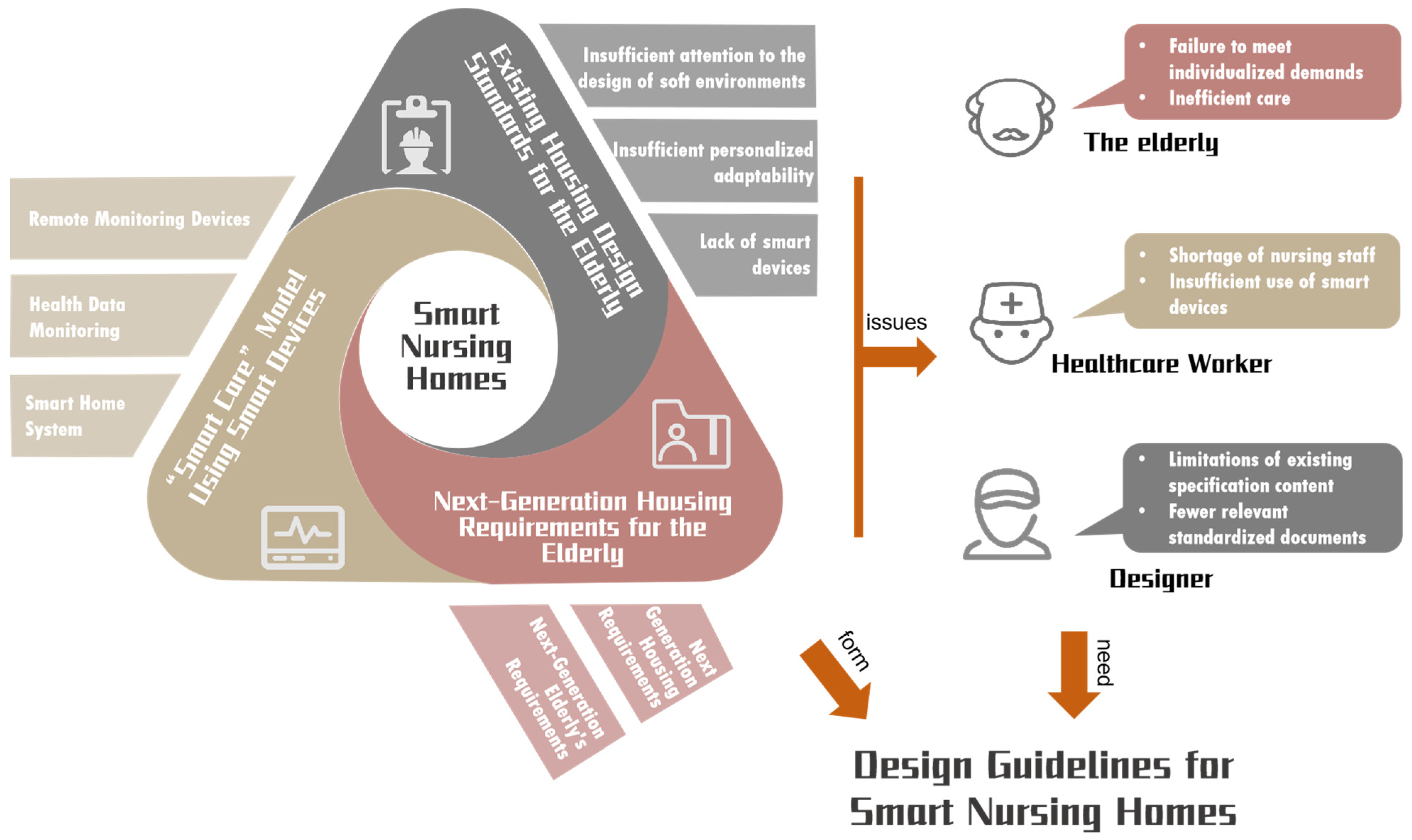

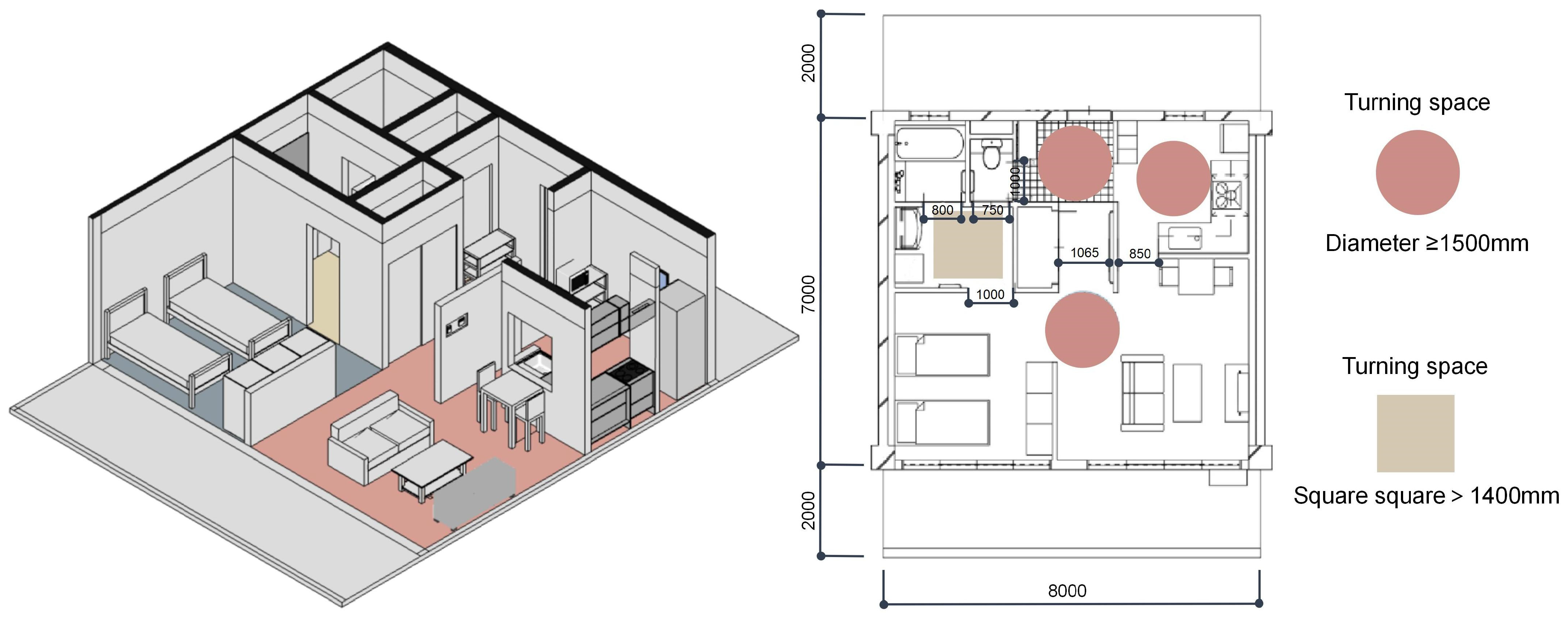
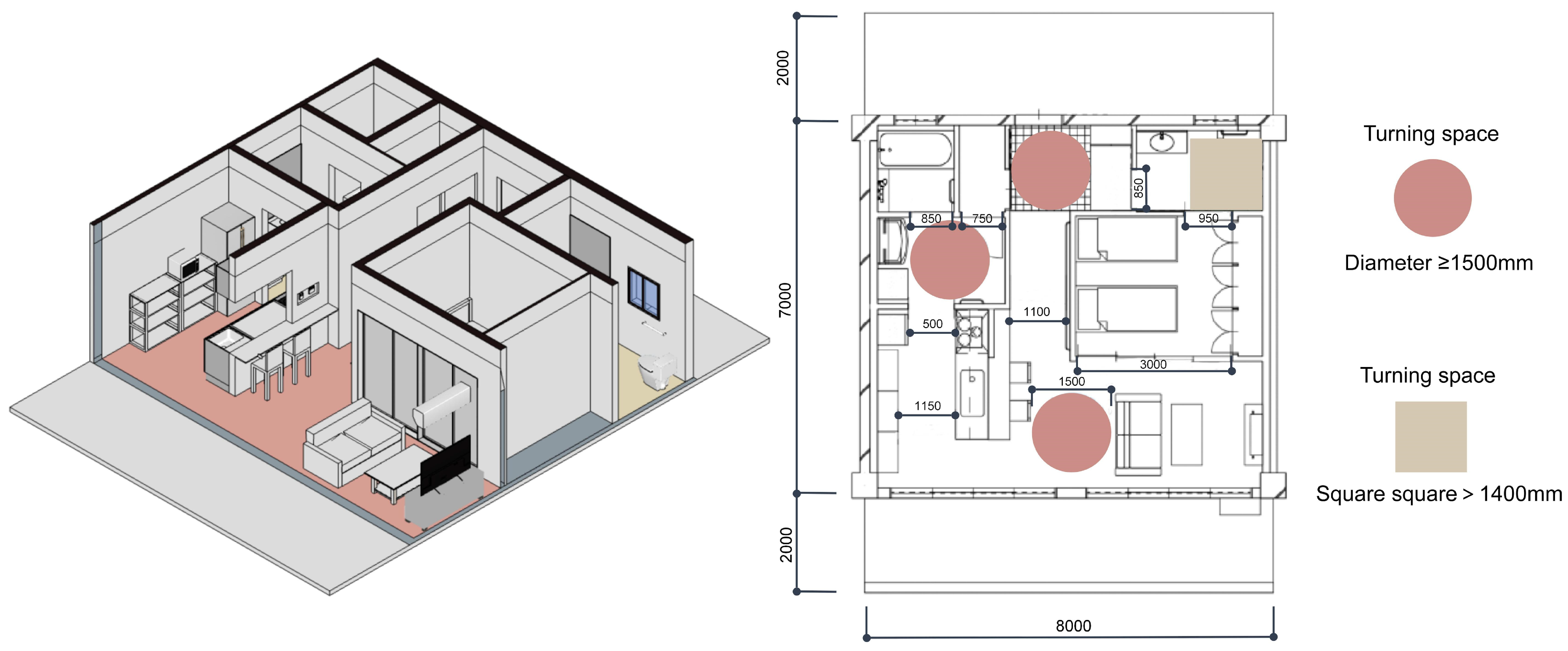
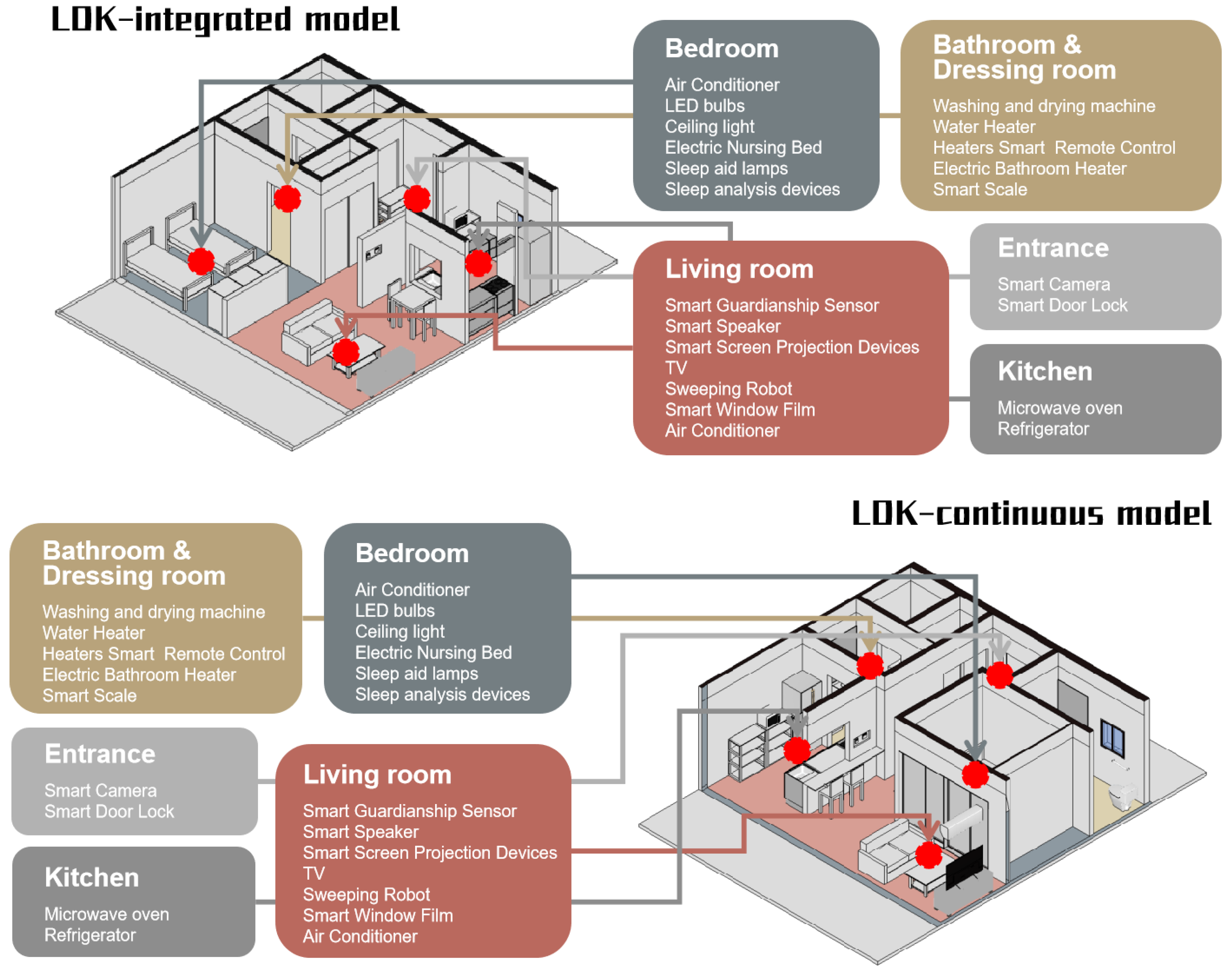

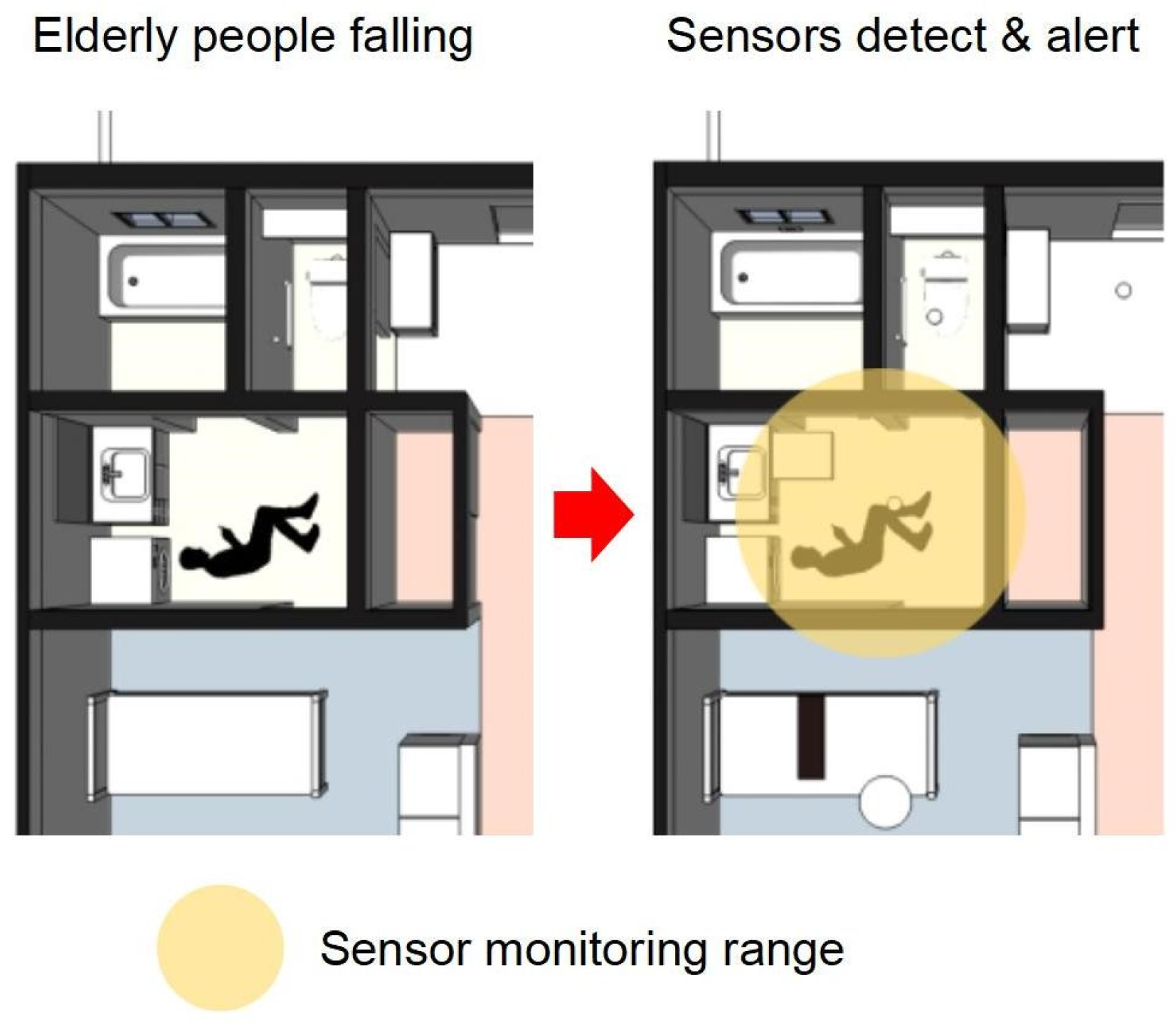


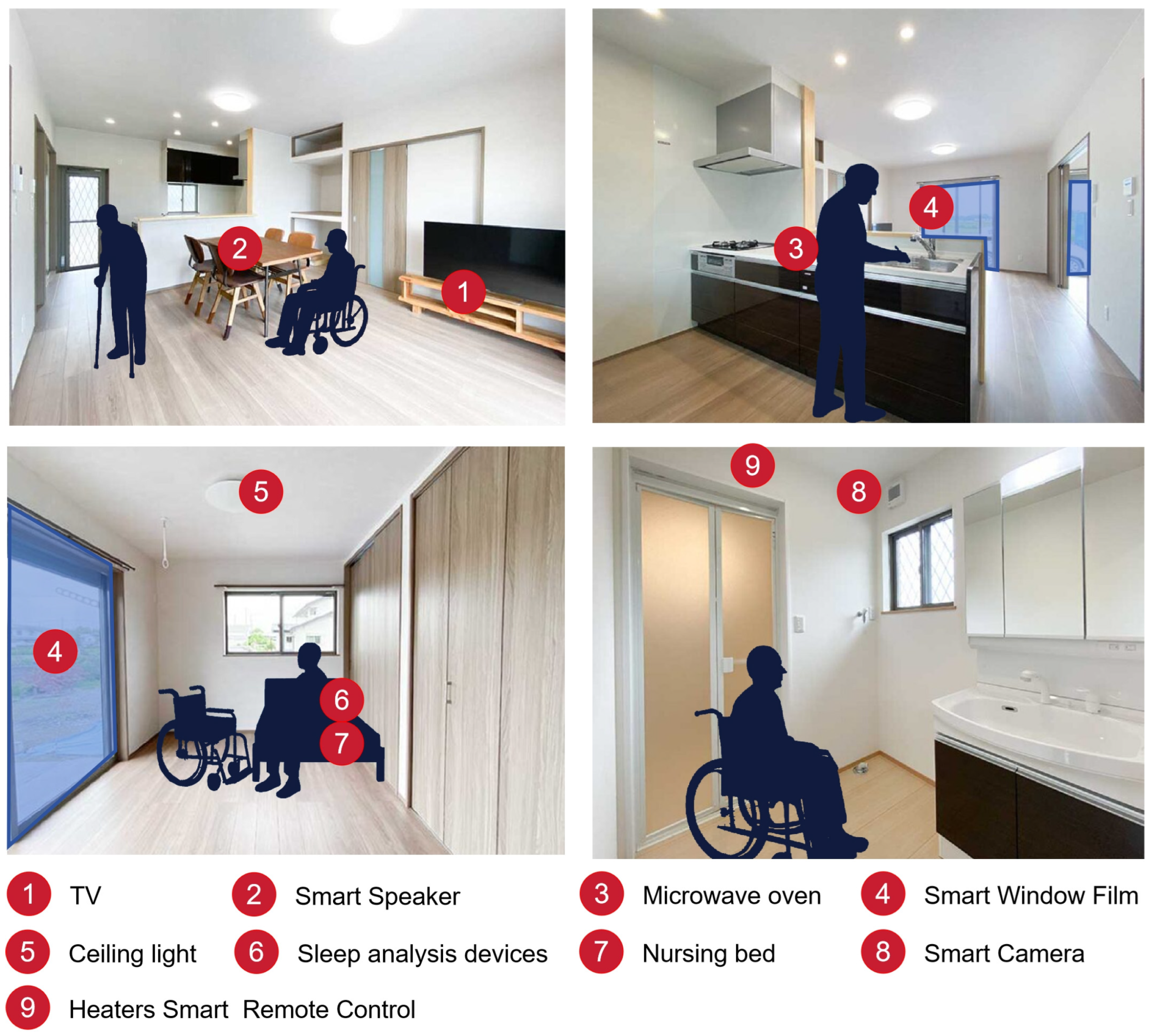
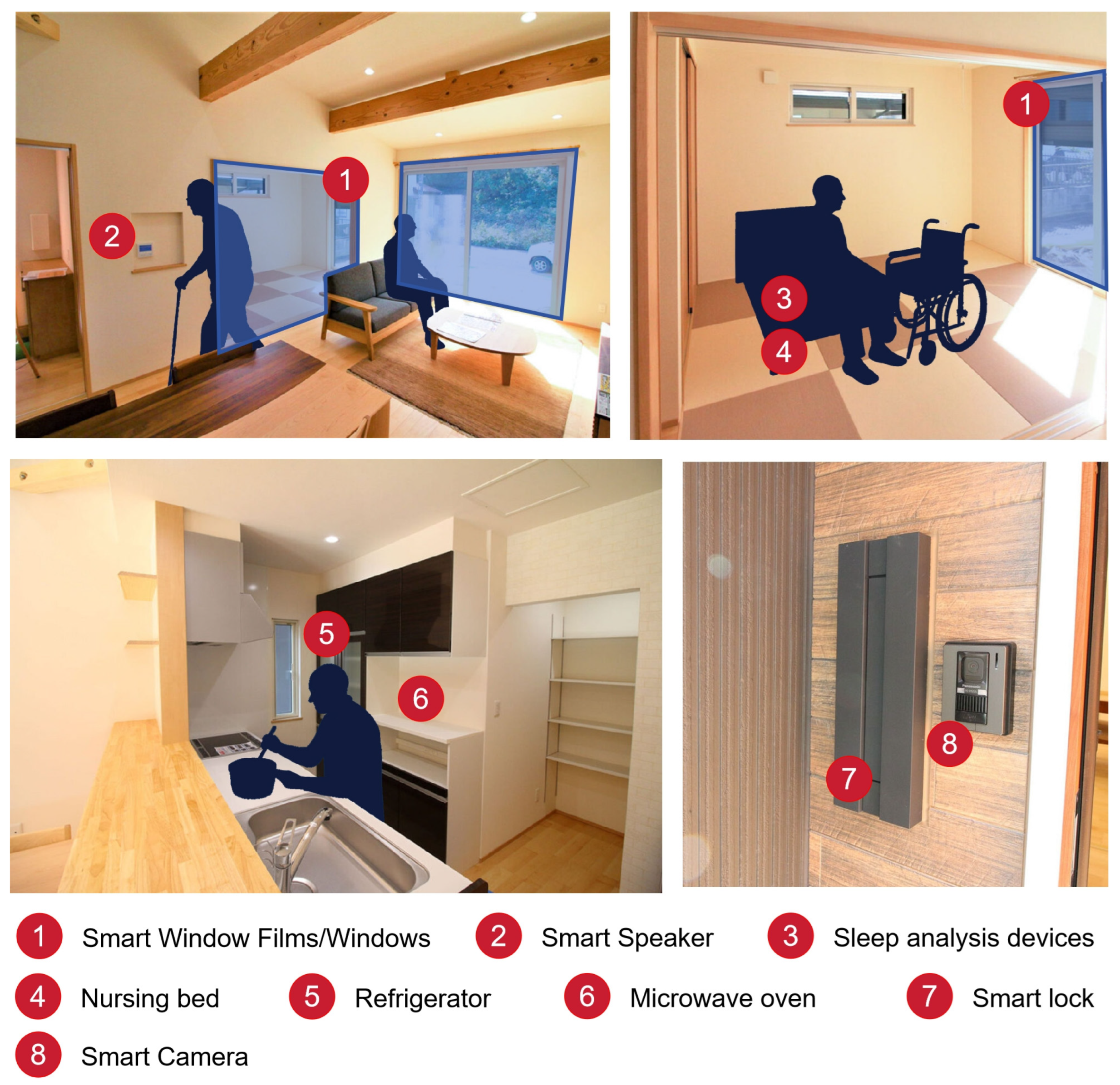
| Types | Content | How Requirements Are Satisfied |
|---|---|---|
| Family Care | Easy for family members to monitor the patient’s condition | Using smart devices (monitoring sensor devices, data transmission devices) |
| Elders can spend more time with family members | Use of smart devices (communication devices, data transmission devices) | |
| Daily Care | Efficient care | Rational floor plan, efficient care flow, use of smart devices |
| Rapid access to physical data of elders | Use of smart devices (monitoring sensor devices) | |
| Care data recording and statistics | Use of smart devices (data analysis devices, data transmission devices) | |
| Privacy and Security | Lifestyle can be maintained | Rational floor plan layout, layout of daily equipment |
| Privacy is maintained when there are visitors | Rational floor plan layout, use of smart devices (smart curtains) | |
| Safe and Easy Mobility | Easy access from the treatment area to the restroom | Rational floor plan layout |
| Easy access from the treatment area to the outside | Rational floor plan layout | |
| Mobility safety is assured without steps or obstacles | Reasonable floor plan layout, use of smart devices (smart curtains) | |
| Activities of daily living can be accomplished in a small area | Reasonable floor plan layout, layout of daily devices, use of smart devices | |
| The function of the living room is maintained as a communal and reception space | Reasonable floor plan layout, use of smart devices | |
| Bathroom and toilet facilities are easily accessible | Reasonable floor plan layout, efficient life flow, use of smart devices | |
| Daily Recreation | Daily recreation with other seniors, family members, etc. | Rational floor plan layout, use of smart devices (remote interactive devices, AR, VR, etc.), rational community planning |
| Achieving Value | Participation in creative activities and realization of the social value of elders | Use of smart devices (smartphones, AR, VR, etc.), rational community planning |
| Location | Name | Usage | Advantage |
|---|---|---|---|
| Bedroom | Ururu Sarara X AN22YRS-W (DAIKIN, Osaka, Japan) | Air conditioner (6 tatami mats) | Convenience (easy control) |
| LDA9L-G/D-86AITG (Iris Ohyama, Sendai, Japan) | Light bulbs | Personalized demand (low blue light, eye protection design) | |
| CL8D-6.0AIT (Iris Ohyama, Sendai, Japan) | Ceiling light (8 tatami mats) | Personalized demand (low blue light, eye protection design) | |
| INTIME2000i (Paramount Bed Co., Tokyo, Japan) | Electric recliner bed | Safety (fall prevention design) | |
| CALM-LITE (Paramount Bed Co., Tokyo, Japan) | Mattress | Personalized demand (spinal support, breathable and anti-bedsore, model compatibility with electric recliner bed) | |
| Active Sleep ANALYZER (Paramount Bed Co., Tokyo, Japan) | Sensor | Safety (smart alarm system) | |
| Living room | DOSITEL (HITACHI, Tokyo, Japan) | Monitoring service | Convenience (easy control) |
| Google Nest Mini (Google, Mountain View, CA, USA) | Smart Speakers | Convenience (easy control) | |
| Chromecast (Google, Mountain View, CA, USA) | Streaming services | Safety (wide-area monitoring) | |
| 4T-C43DN2 (SHARP, Osaka, Japan) | TVs | Convenience (easy control); Personalized demand (low blue light, eye protection design) | |
| Roomba i3+ (iRobot, Bedford, MA, USA) | Robot vacuum cleaners | Convenience (easy control) | |
| LCD light control film (Toppan Printing Co., Tokyo, Japan) | Smart window | Convenience (easy installation); Safety (seismic protection) | |
| Ururu Sarara X (DAIKIN, Osaka, Japan) | Air conditioner (6 tatami mats) | Convenience (easy control) | |
| Bathroom and Dressing room | BD-SX110FL (HITACHI, Tokyo, Japan) | Washer/dryer | Personalized demand (automatic washing and drying, sterilization mode) |
| GH-HK245ZW (PURPOSE, Numazu, Japan) | Water heater | Convenience (easy control); Safety (temperature control to prevent scalding) | |
| TC-921ZT-WID (PURPOSE, Numazu, Japan) | Remote controls for heat source units for water heaters and hot water heating | Convenience (easy control); Safety (temperature control to prevent scalding) | |
| FY-13UG7E (Panasonic, Osaka, Japan) | Electric bath ventilation dryer | Convenience (easy control); Personalized demand (warm air mode) | |
| HBF-228T (Omron, Kyoto, Japan) | Scales | Convenience (voice prompt) | |
| Kitchen | AX-XW600 (SHARP, Osaka, Japan) | Microwave oven | Convenience (voice prompt); Safety (temperature control to prevent scalding) |
| SJ-GA50E (SHARP, Osaka, Japan) | Refrigerator | Personalized demand (low energy consumption, quiet operation) | |
| Entrance | VS-HC400K (Panasonic, Osaka, Japan) | Door camera kit with monitor | Safety (fraud prevention, smart alarm system) |
| ES-F500D (EPIC, Seoul, Republic of Korea) | Smart locks | Safety (fraud prevention, smart alarm system) |
| Location | Name | Smartphone Controls | Speaker Controls | Other Controls |
|---|---|---|---|---|
| Bedroom | Ururu Sarara X (DAIKIN, Osaka, Japan) | ⃝ | ⃝ | Remote Controls |
| LDA9L-G/D-86AITG (Iris Ohyama, Sendai, Japan) | ⃝ | ⃝ | Switch/Remote Controls | |
| CL8D-6.0AIT (Iris Ohyama, Sendai, Japan) | ⃝ | ⃝ | Switch/Remote Controls | |
| INTIME2000i (Paramount Bed Co., Tokyo, Japan) | ⃝ | Remote Controls | ||
| CALM-LITE (Paramount Bed Co., Tokyo, Japan) | No other Controls | |||
| Active Sleep ANALYZER (Paramount Bed Co., Tokyo, Japan) | ⃝ | Remote Controls | ||
| Living room | DOSITEL (HITACHI, Tokyo, Japan) | ⃝ | No other Controls | |
| Google Nest Mini (Google, Mountain View, CA, USA) | ⃝ | Main unit Controls | ||
| Chromecast (Google, Mountain View, CA, USA) | ⃝ | No other Controls | ||
| 4T-C43DN2 (SHARP, Osaka, Japan) | ⃝ | Remote Controls | ||
| Roomba i3+ (iRobot, Bedford, MA, USA) | ⃝ | ⃝ | Button Controls | |
| LCD light control film (Toppan Printing Co., Tokyo, Japan) | Switch | |||
| Ururu Sarara X (DAIKIN, Osaka, Japan) | ⃝ | ⃝ | Remote Controls | |
| Bathroom and Dressing room | BD-SX110FL (HITACHI, Tokyo, Japan) | Switch | ||
| GH-HK245ZW (PURPOSE, Numazu, Japan) | No other Controls | |||
| TC-921ZT-WID (PURPOSE, Numazu, Japan) | ⃝ | Switch | ||
| FY-13UG7E (Panasonic, Osaka, Japan) | Switch | |||
| HBF-228T (Omron, Kyoto, Japan) | No other Controls | |||
| Kitchen | AX-XW600 (SHARP, Osaka, Japan) | ⃝ | Voice Controls | |
| SJ-GA50E (SHARP, Osaka, Japan) | ⃝ | Commonly utilized | ||
| Entrance | VS-HC400K (Panasonic, Osaka, Japan) | ⃝ | Switch | |
| ES-F500D (EPIC, Seoul, Republic of Korea) | ⃝ | Commonly utilized |
| House Models | Overview | Space Layout Requirements | Aging-Friendly Design Rules | Disadvantages |
|---|---|---|---|---|
| LDK-integrated model | LDK-integrated models refer to integrated living room-dining room-kitchen (LDK) models, which are designed to optimize the use of space and improve living comfort. | Ensure that the living room, dining room, and kitchen areas are open and connected to improve mobility. | 1. Channel width: ≥900 mm. 2. Barrier-free design: no height difference on the ground, with a gentle slope in the bathroom. 3. Safety handrails: handrails are installed in the bathroom, corridor, and bedside. 4. Bathroom, dressing room, and living room set rotary space diameter: ≥1500 mm. Bathroom interior space: ≥1500 mm × 1500 mm. 5. Toilet set rotary space diameter: ≥1400 mm. Toilet internal square space: ≥1500 mm × 1500 mm. 6. Door width: single door ≥ 800 mm, double doors ≥ 850 mm. | 1. There is a blind spot in the room, which makes it impossible for healthcare workers to accurately assist the elderly immediately after an emergency occurs. 2. There is no wall between the bedroom and the living room, making it difficult to ensure privacy. 3. The distance between the entrance and the bedroom is far and not easy to move. 4. The long flow of housekeeping services makes it inconvenient for caregivers to work. |
| Avoid narrow passageways to ensure wheelchair accessibility. | ||||
| Have at least one bedroom adjacent to the LDK area for easy access by the caregiver. | ||||
| LDK-continuous model | LDK-continuous models refer to living room–dining room–kitchen (LDK) continuous models, which are designed to optimize the care environment for the elderly and improve the ease of living. | Keep the living room, dining room, and kitchen connected to form a smooth line of life and activity. | 1. Smaller living space. 2. Bathrooms and toilets are far apart. 3. A long flow for caregivers to take care of the elderly, which may be troublesome and difficult. | |
| Adjustable partitions to enhance spatial flexibility. | ||||
| Provide barrier-free access for wheelchairs and walkers. |
| Location | Device Type | Ways to Detect Human Movement | Capability of Transmission and Sharing of User Information | Operability | Correspondence with the Smart Nursing Home Template |
|---|---|---|---|---|---|
| Bedroom | Air Conditioner | pre-installed devices | non-initiated uploading | Smartphone Controls, Speaker Controls, Remote Controls | / |
| LED bulbs | pre-installed devices | non-initiated uploading | Smartphone Controls, Speaker Controls, Switch/Remote Controls | / | |
| Ceiling light | pre-installed devices | independent operation | Smartphone Controls, Speaker Controls, Switch/Remote Controls | / | |
| Electric Nursing Bed | pre-installed devices | independent operation | Smartphone Controls, Remote Controls | LDK-integrated model and LDK-continuous model: long caretaking flow line | |
| Sleep aid lamps | pre-installed devices | independent operation | / | / | |
| Sleep analysis devices | pre-installed devices | real-time uploading | Smartphone Controls, Remote Controls | LDK-integrated model and LDK-continuous model: long caretaking flow line | |
| Living room | Smart Guardianship Sensor | wearable devices worn by the user | real-time uploading | Smartphone Controls | LDK-integrated model: blind spot; LDK-continuous model: long caretaking flow line |
| Smart Speaker | communication devices operated by the user | real-time uploading | Speaker Controls, Main Unit Controls | / | |
| Smart Screen Projection Devices | communication devices operated by the user | non-initiated uploading | Smartphone Controls | / | |
| TV | pre-installed devices | non-initiated uploading | Speaker Controls, Remote Controls | / | |
| Sweeping Robot | pre-installed devices | real-time uploading | Smartphone Controls, Speaker Controls, Button Controls | LDK-integrated model: long caretaking flow line | |
| Smart Window Film | pre-installed devices | non-initiated uploading | Switch | LDK-integrated model: difficulty in ensuring privacy; LDK-continuous model: long caretaking flow line | |
| Air Conditioner | pre-installed devices | non-initiated uploading | Smartphone Controls, Speaker Controls, Remote Controls | / | |
| Bathroom and Dressing room | Washing and drying machine | pre-installed devices | independent operation | Switch | LDK-integrated model: long caretaking flow line |
| Water Heater | pre-installed devices | non-initiated uploading | / | LDK-integrated model: long caretaking flow line | |
| Heaters Smart Remote Control | pre-installed devices | non-initiated uploading | Smartphone Controls, Switch | LDK-integrated model: long caretaking flow line | |
| Electric Bathroom Heater | pre-installed devices | independent operation | Switch | LDK-integrated model: long caretaking flow line | |
| Smart Scale | wearable devices worn by the user | real-time uploading | / | LDK-continuous model: long caretaking flow line | |
| Kitchen | Microwave oven | pre-installed devices | independent operation | Smartphone Controls, Voice Controls | / |
| Refrigerator | pre-installed devices | independent operation | Smartphone Controls, Commonly utilized | / | |
| Entrance | Smart Camera | communication devices operated by the user | real-time uploading | Smartphone Controls, Switch | LDK-integrated model: blind spot; LDK-continuous model: long caretaking flow line |
| Smart Door Lock | communication devices operated by the user | real-time uploading | Smartphone Controls, Commonly utilized | LDK-integrated model: Difficulty in ensuring privacy |
Disclaimer/Publisher’s Note: The statements, opinions and data contained in all publications are solely those of the individual author(s) and contributor(s) and not of MDPI and/or the editor(s). MDPI and/or the editor(s) disclaim responsibility for any injury to people or property resulting from any ideas, methods, instructions or products referred to in the content. |
© 2025 by the authors. Licensee MDPI, Basel, Switzerland. This article is an open access article distributed under the terms and conditions of the Creative Commons Attribution (CC BY) license (https://creativecommons.org/licenses/by/4.0/).
Share and Cite
Teng, X.; Shen, Z.; Zhang, Y. Design Guidelines for Smart Nursing Homes in the Context of Aging. Buildings 2025, 15, 1516. https://doi.org/10.3390/buildings15091516
Teng X, Shen Z, Zhang Y. Design Guidelines for Smart Nursing Homes in the Context of Aging. Buildings. 2025; 15(9):1516. https://doi.org/10.3390/buildings15091516
Chicago/Turabian StyleTeng, Xiao, Zhenjiang Shen, and Yuntian Zhang. 2025. "Design Guidelines for Smart Nursing Homes in the Context of Aging" Buildings 15, no. 9: 1516. https://doi.org/10.3390/buildings15091516
APA StyleTeng, X., Shen, Z., & Zhang, Y. (2025). Design Guidelines for Smart Nursing Homes in the Context of Aging. Buildings, 15(9), 1516. https://doi.org/10.3390/buildings15091516








